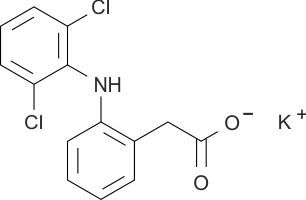Diclofenac Potassium API
| Cas No : | 15307-81-0 |
|---|---|
| Name : | Diclofenac Potassium |
| Synonyms : | N-(2,6-Dichlorophenyl)-o-aminophenylacetic Acid Sodium Salt;sodium(o-((2,6-dichlorophenyl)amino)phenyl)acetate |
| Molecular Formula : | C14H10Cl2KNO2 |
| Melting Point : | 300-330 °C |
| Boiling Point : | 412 °C |
| Molecular Weight : | 334.24 |
| Density : | N/A |
| Solubility : | Slightly soluble in water under acidic pH; solubility increases as the pH increases to 7.5. |
Uses :
- It can also used to treat dysmenorrhea. It can treat inflammatory disorders such as musculoskeletal complaints, dental pain, arthritis, actinic keratosis, joint pain, acute pain and chronic pain caused by certain kinds of cancers. Traditional opinion proposes that diclofenac exerts its action via inhibition of prostaglandin synthesis by inhibiting cyclooxygenase-1 (COX-1) and cyclooxygenase-2 (COX-2) with relative equipotency. However, recent studies have shown that the pharmacologic activity of diclofenac goes beyond COX inhibition, and includes multimodal and, in some instances, novel mechanisms of action (MOA). For example, research suggests diclofenac can inhibit the thromboxane-prostanoid receptor, affect arachidonic acid release and uptake, inhibit lipoxygenase enzymes, and activate the nitric oxide–cGMP antinociceptive pathway. Other novel MOAs may include the inhibition of substrate P, inhibition of peroxisome proliferator activated receptor gamma (PPARγ), blockage of acid-sensing ion channels, alteration of interleukin-6 production, and inhibition of N-methyl-D-aspartate (NMDA) receptor hyperalgesia.






